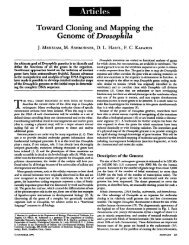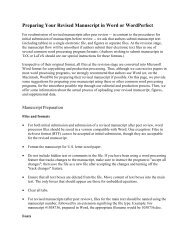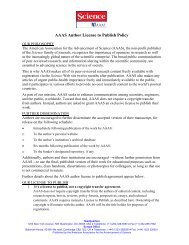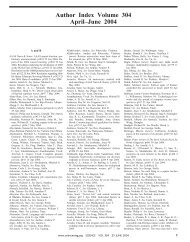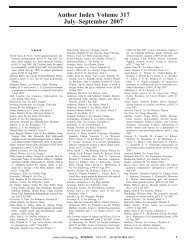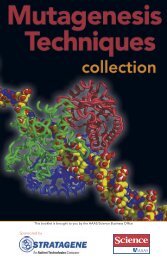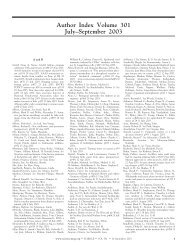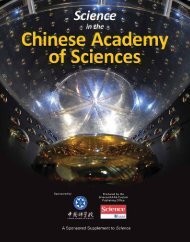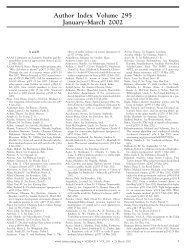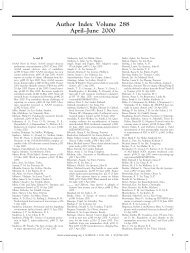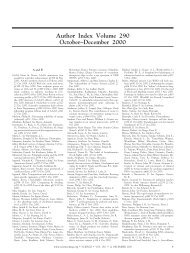Duesberg and Critics Agree: Hemophilia Is the Best Test - Science
Duesberg and Critics Agree: Hemophilia Is the Best Test - Science
Duesberg and Critics Agree: Hemophilia Is the Best Test - Science
You also want an ePaper? Increase the reach of your titles
YUMPU automatically turns print PDFs into web optimized ePapers that Google loves.
1<br />
2<br />
3<br />
4<br />
5<br />
6<br />
7<br />
8<br />
9<br />
10<br />
11<br />
12<br />
13<br />
14<br />
15<br />
16<br />
17<br />
18<br />
19<br />
20<br />
21<br />
22<br />
23<br />
24<br />
25<br />
26<br />
27<br />
28<br />
29<br />
30<br />
31<br />
32<br />
33<br />
34<br />
35<br />
36<br />
37<br />
38<br />
39<br />
40<br />
41<br />
42<br />
43<br />
44<br />
45<br />
46<br />
47<br />
48<br />
49<br />
50<br />
51<br />
52<br />
53<br />
54<br />
55<br />
56<br />
57<br />
58<br />
59<br />
60<br />
61<br />
62<br />
63<br />
64<br />
65<br />
66<br />
The Transfusion Studies<br />
Although science has produced no AIDS cure or vaccine, AIDS researchers like to<br />
point to one dramatic victory: <strong>the</strong> blood test that prevents people from being infected<br />
during transfusions. According to <strong>the</strong> Centers for Disease Control <strong>and</strong> Prevention<br />
(CDC), as of mid-1994, 6888 AIDS cases had been linked to blood transfusions. But<br />
those people were almost all infected before screening began, <strong>and</strong> <strong>the</strong> blood test has<br />
essentially eliminated <strong>the</strong> risk of AIDS from transfusions—only 29 cases stem from<br />
blood that was screened for HIV. This dramatic decrease has been invoked by AIDS<br />
researchers as evidence that HIV causes AIDS.<br />
Peter <strong>Duesberg</strong> says <strong>the</strong>se data are meaningless. He argues that AIDS is not caused by<br />
HIV in transfused blood but by <strong>the</strong> disease that required transfusion in <strong>the</strong> first place.<br />
And, he says, <strong>the</strong> drop in AIDS cases after HIV was removed from <strong>the</strong> blood supply has<br />
a “trivial explanation.” Because <strong>the</strong> st<strong>and</strong>ard definition of AIDS requires <strong>the</strong> presence of<br />
HIV, when <strong>the</strong> virus was removed from <strong>the</strong> blood supply, people were no longer<br />
categorized as having AIDS—although <strong>the</strong>ir diseases had not changed. “Without HIV<br />
antibodies,” contends <strong>Duesberg</strong>, “<strong>the</strong> diseases are called by <strong>the</strong>ir old names.”<br />
Proof that AIDS has vanished along with HIV, <strong>Duesberg</strong> says, would be a decrease in<br />
AIDS-defining diseases among transfusion recipients <strong>and</strong> a corresponding decrease in<br />
transfusion-associated mortality. In an interview with <strong>Science</strong> he criticized CDC scientists—whom<br />
he described as “officers of <strong>the</strong> U.S. Army who are paid to find HIV is <strong>the</strong><br />
cause of AIDS”—for not providing that data. Harold Jaffe, head of <strong>the</strong> CDC’s Division<br />
of HIV/AIDS, said “I don’t believe <strong>the</strong>re’s national mortality data for all who have been<br />
transfused.” Jaffe added that he doesn’t think such figures would be “particularly useful”<br />
in relation to AIDS causality “because <strong>the</strong> overall mortality in people who are transfused<br />
is high, <strong>and</strong> AIDS has contributed relatively little.”<br />
<strong>Duesberg</strong> also argues that mainstream AIDS researchers attribute death among<br />
transfusion recipients to HIV “without considering HIV-free controls.” But in 1990 <strong>the</strong><br />
Transfusion Safety Study Group (TSSG) published just such a report. The TSSG<br />
compared HIV-negative <strong>and</strong> HIV-positive recipients who had been given transfusions<br />
for similar diseases. Approximately 3 years after transfusion, <strong>the</strong> mean CD4 count in 64<br />
HIV-negative recipients was 850 (<strong>the</strong> normal adult range is 600 to 1200). In contrast,<br />
111 HIV positives had an average of 375 CD4s. By May 1993, <strong>the</strong>re were 37 AIDS cases<br />
in <strong>the</strong> HIV-infected group, says TSSG Director James Mosley of <strong>the</strong> University of<br />
Sou<strong>the</strong>rn California. In contrast, <strong>the</strong>re has not been a single AIDS-defining illness in<br />
<strong>the</strong> HIV-negative transfusion recipients, says Mosley.<br />
<strong>Duesberg</strong> says <strong>the</strong>se data neatly fit his <strong>the</strong>ories. HIV, he says, is a rare contaminant of<br />
blood transfusions <strong>and</strong> <strong>the</strong>refore indicates <strong>the</strong> volume of transfusions received. “HIVpositive<br />
transfusion recipients have received more blood because <strong>the</strong>y had more severe<br />
underlying diseases than HIV negatives,” he wrote in response to questions from <strong>Science</strong>.<br />
“The more severe <strong>the</strong> underlying disease, <strong>the</strong> more likely are subsequent AIDS diseases.”<br />
–J.C.<br />
base. Goedert analyzed which was better correlated<br />
with a hemophiliac’s risk of death:<br />
cumulative dosage of factor VIII or having<br />
tested positive for HIV. (He did not use<br />
AIDS as an endpoint because since <strong>the</strong> mid-<br />
1980s, when <strong>the</strong> medical community accepted<br />
HIV as <strong>the</strong> cause of AIDS, clinicians<br />
have primarily diagnosed AIDS in people<br />
who test positive for HIV.)<br />
To make <strong>the</strong> comparison, Goedert divided<br />
hemophiliacs of similar age into HIVpositive<br />
<strong>and</strong> HIV-negative groups. He <strong>the</strong>n<br />
divided <strong>the</strong> two groups into those who had<br />
received high, moderate, or low cumulative<br />
dosages of factor VIII. Dosages were totaled<br />
from 1978 to 1984; <strong>the</strong> study analyzed <strong>the</strong><br />
hemophiliacs’ survival from 1985 on.<br />
The 29 people in <strong>the</strong> highest dose category<br />
were all infected with HIV <strong>and</strong> <strong>the</strong>refore<br />
could not be used in <strong>the</strong> comparison. In<br />
<strong>the</strong> moderate-dose group, <strong>the</strong>re were 264<br />
HIV positives. Of that total, 103 have died.<br />
In comparison, among 17 HIV negatives<br />
<strong>the</strong>re were no deaths. In <strong>the</strong> low-dose group,<br />
<strong>the</strong>re were 103 HIV positives, of whom 40<br />
have died; among 49 HIV negatives <strong>the</strong>re<br />
has been only one death. Dosage of factor<br />
VIII, says Goedert, “had absolutely nothing<br />
whatsoever” to do with a person’s risk of dying.<br />
Being HIV positive, however, increased<br />
a person’s risk of dying almost 20-fold.<br />
Goedert’s counterpart, TSSG Director<br />
Mosley, offers additional data that he says<br />
link HIV to disease <strong>and</strong> death, specifically<br />
illnesses associated with AIDS. Data from<br />
<strong>the</strong> TSSG reported in <strong>the</strong> New Engl<strong>and</strong> Journal<br />
of Medicine in 1993 show that none of <strong>the</strong><br />
419 HIV negatives from that large study had<br />
AIDS-defining diseases. In contrast, Mosley<br />
says, by May 1993, <strong>the</strong> most recent analysis,<br />
1646 SCIENCE • VOL. 266 • 9 DECEMBER 1994<br />
165, or 31%, of <strong>the</strong> 519 HIV-positive hemophiliacs<br />
had developed AIDS. In <strong>the</strong> HIVpositive<br />
group <strong>the</strong>re were 176 deaths, <strong>and</strong> of<br />
those, 135 were from AIDS.<br />
For many “HIV dissenters,” <strong>Duesberg</strong>’s<br />
most compelling argument against HIV as<br />
<strong>the</strong> cause of AIDS in hemophiliacs is his<br />
observation that <strong>the</strong> median age of hemophiliacs<br />
has increased in spite of high HIV<br />
infection rates. As <strong>Duesberg</strong> notes, studies<br />
have reported that <strong>the</strong> median age of hemophiliacs<br />
in <strong>the</strong> United States has risen from<br />
11 years in 1972 to more than 25 years by <strong>the</strong><br />
early 1980s. “Thus,” he says, “one could<br />
make a logical argument that HIV, instead<br />
of decreasing <strong>the</strong> lifespan of hemophiliacs,<br />
has in fact increased it.”<br />
Researchers who study health patterns<br />
among hemophiliacs agree that life-span in<br />
this group has increased over <strong>the</strong> last two<br />
decades. But if were not for HIV, <strong>the</strong>y say,<br />
<strong>the</strong> increase would have been far higher.<br />
What is more, <strong>the</strong>y argue that life-span among<br />
hemophiliacs has actually been sharply decreasing<br />
recently.<br />
That conclusion is supported by a study<br />
from <strong>the</strong> Centers for Disease Control <strong>and</strong><br />
Prevention (CDC), published this year in<br />
<strong>the</strong> American Journal of Hematology, evaluating<br />
two decades of death certificates from<br />
hemophiliacs. CDC’s Terence Chorba <strong>and</strong><br />
his co-workers concluded that, because of<br />
<strong>the</strong> introduction in <strong>the</strong> 1960s of clotting<br />
treatments that prevent death from hemorrhage,<br />
death rates dropped from 0.5 to 0.4<br />
per million from 1968 to 1978. But from<br />
1979 to 1989, <strong>the</strong> period when most U.S.<br />
hemophiliacs became infected with HIV,<br />
<strong>the</strong> death rate among hemophiliacs increased<br />
dramatically—to 1.3 per million.<br />
The same study provides o<strong>the</strong>r perspectives<br />
on <strong>the</strong> sharp increases in death rates<br />
among hemophiliacs due to AIDS. The median<br />
age at death of all U.S. hemophiliacs<br />
fell from a high of 63 in 1983 to 38 in 1989.<br />
That change was due to <strong>the</strong> increase in deaths<br />
among HIV-positive hemophiliacs, <strong>the</strong> authors<br />
note, which soared from 19.9% in <strong>the</strong><br />
period 1983–1985 to 55.1% in <strong>the</strong> period<br />
1987–1989. Chorba <strong>and</strong> his colleagues conclude<br />
that <strong>the</strong> spread of HIV “significantly<br />
disrupted <strong>the</strong> progress in mortality statistics<br />
for this population.”<br />
<strong>Duesberg</strong> replies that this study “confirms<br />
very much everything I have said.” He argues<br />
that <strong>the</strong> life-span dropped between 1987 <strong>and</strong><br />
1989 because of “<strong>the</strong> large-scale administration<br />
of AZT to American hemophiliacs.” He<br />
calls <strong>the</strong> drop “an iatrogenic artifact.”<br />
For researchers such as TSSG’s Mosley,<br />
however, <strong>the</strong> hemophilia data leave no question<br />
that HIV causes AIDS. Indeed, says Mosley,<br />
in <strong>the</strong> face of <strong>the</strong> data on hemophiliacs<br />
he has a hard time underst<strong>and</strong>ing why <strong>Duesberg</strong><br />
continues to stick to his arguments.<br />
–Jon Cohen<br />
66<br />
65<br />
64<br />
63<br />
62<br />
61<br />
60<br />
59<br />
58<br />
57<br />
56<br />
55<br />
54<br />
53<br />
52<br />
51<br />
50<br />
49<br />
48<br />
47<br />
46<br />
45<br />
44<br />
43<br />
42<br />
41<br />
40<br />
39<br />
38<br />
37<br />
36<br />
35<br />
34<br />
33<br />
32<br />
31<br />
30<br />
29<br />
28<br />
27<br />
26<br />
25<br />
24<br />
23<br />
22<br />
21<br />
20<br />
19<br />
18<br />
17<br />
16<br />
15<br />
14<br />
13<br />
12<br />
11<br />
10<br />
9<br />
8<br />
7<br />
6<br />
5<br />
4<br />
3<br />
2<br />
1



